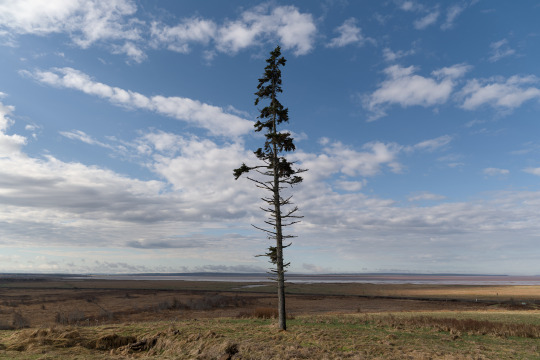#fort beausejour
Text

Saturday October 8/2022
We started our day with dark grey clouds, rain, and strong winds. It got more interesting as we were watching the Moncton tidal bore at 9:15 am. A surfer was waiting patiently in the muddy water for the tide to rush in. The sound of waves hitting the rocks was loud, and we could hear it before seeing any water movement. It was amazing, a wave more than a metre high came around the corner and slowly moved up the still river churning and curling as it crawled by against the current.
Our first stop was the historic Monument-Lefebvre: a college built as tribute to the Acadians. The Acadians were French settlers, who moved into the Maritimes, but were deported when the British took over. Some eventually returned over time, but others resettled to the south. Those in Louisiana became known as Cayjuns. The lady in charge, showed us the main lecture theatre with curved wooden seats, and explained everything to us. She was a jewel for such a place!
Next was Fort Beausejour: The French strong hold built on a lone hill in the flatlands between New Brunswick and Nova Scotia.
Simon almost hit a sleepy porcupine on a back road. We stopped to take pictures of it.
In the town of Parrsboro we visited historic Ottawa house, which was a summer home for one of the earliest signers of Canadian confederation and now a museum. They were serving soup today, but we were late.
Next was the tidal research center, where they are experimenting with energy producing turbines underwater in the narrow Minas Strait that has some of the fastest currents in the world from the world’s highest tide change height in the Bay of Fundy.
After Truro we started to see the first hurricane Fiona damage in the form of trees knocked down onto power wires and flooding erosion in the creeks. We made stops at the Tidal Interpretive centre and some more flowerpot rocks. We watched the orange sunset and ended our day by driving towards a full moon.
1 note
·
View note
Photo

pretending to be @mostlythemarsh with this one
2 notes
·
View notes
Photo

There’s just something about taking a moment and appreciating the view around you.
0 notes
Video
Fort Walls by Kathryn Adams
Via Flickr:
Fort Beausejour, NB
20120613 enjoyed my visit here
0 notes
Text
Fort beausejour in between Sackville NB Na the Nova Scotia border






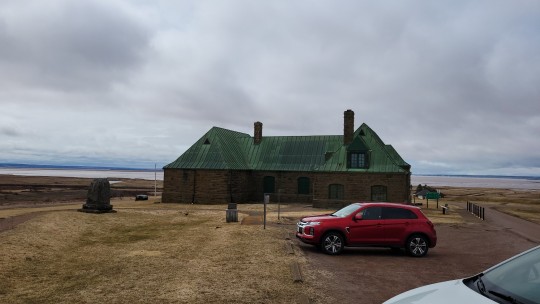

1 note
·
View note
Link
#wheretonext#jogginsfossilcliffs#fortbeausejour#advocateharbour#newbrunswick#novascotia#visitnovascotia#canada#visitcanada#roadtripcanada#driving#drivinglife#travelblog#canadiantravellers#RoadTrip#ontheroad#stealthcamping#carcamping#carcampingadventures
0 notes
Photo

In Game:
Edward Braddock, also known as “The Bulldog,” was a General in the British Army and a member of the Templar Order.
Braddock became a soldier in the British Army and a member of the Templar Order under Reginald Birch. He was introduced to Haytham Kenway in 1735, after his half-sister Jenny was kidnapped, and promised to lead the investigation into her whereabouts, and those of Jack Digweed, whom Haytham suspected was behind the attack. Secretly, however, Birch and Braddock sent the mercenaries to kidnap Jenny in a ploy to obtain Edward Kenway's journal, and to induct Haytham into the Templars.
By 1747, Braddock was a Lieutenant Colonel in the Coldstream Guards, when Haytham tracked one of his mercenaries, Tom Smith, to the regiment in the Dutch Republic. Braddock had Smith hung on grounds of desertion before Haytham could interrogate him, but gave his fellow Templar permission to investigate among his troops. He also requested his help against the French Army, who had commenced the siege of Bergen op Zoom.
In a letter between Braddock and Birch, Braddock revealed that the true reason for Smith's execution was to cover up any loose ends regarding the attack on the Kenway mansion. Braddock also expressed his distaste over Birch's fanatical obsession over the First Civilization artifacts, seeing them to have compromised the Order.
Two months later, the French had won. During the retreat from the siege, Braddock refused a young man's request to allow his family entry onto Braddock and Haytham's boat. After the young man called him craven, Braddock ordered his executioner Slater to kill every last one of them, despite Haytham’s wishes.
After this, Braddock and Haytham fought in several other campaigns, though Braddock became increasingly violent and cruel to the point that he ruthlessly killed civilians and his own allies alike without the non-corrupt authorities knowing, much to Haytham's shock. Haytham told Birch that he was concerned that Braddock was turning away from the Order, but Birch was indifferent.
By 1754, Braddock had been promoted to General, and was serving as governor of Gibraltar when he was sent to Boston, with Charles Lee serving under his command. At this point, Braddock had left the Templar Order, although he was still willing to comply with releasing Lee, although not John Pitcairn.
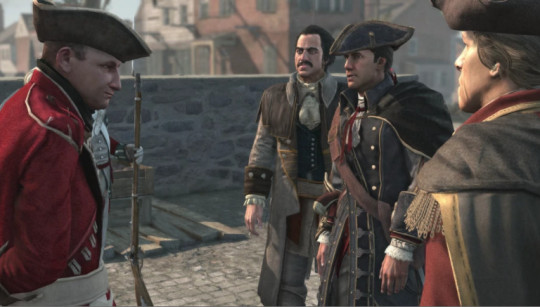
As conflict and territorial disputes between the British and the French colonies escalated, Braddock was given command of two regiments and was assigned to retake Fort Duquesne from the French. In order to navigate through the frontier, Braddock enlisted George Washington, a volunteer from the Virginia Militia, as a guide.
In the winter of 1754, France offered a truce, of which Braddock refused. Instead, Braddock continued on his offensive, determined to defeat and drive the French from the land. While rallying his troops and supplies, Braddock attacked several Native American villages, driving the inhabitants out of their land. As a result, Braddock became an enemy of several Iroquois clans, whom Haytham would eventually join forces with in a plan to murder Braddock.
The expedition continued on until July of 1755, during which Braddock killed one of his own soldiers after accusing him of treasonous and insubordinate behavior. Braddock was then approached by Haytham, disguised as a British soldier, who held him at gunpoint. It was then that the Native American tribes ambushed the soldiers.
Braddock tried to escape, although Haytham attempted to pursue him. Washington briefly tried to come to Braddock’s aid, but was prevented from doing so by a Kanien'kehá:ka woman named Kaniehtí:io. Haytham killed Braddock with his hidden blade and took away his Templar ring.
In Real Life:
Edward Braddock was born in January of 1695 in Perthshire, Scotland. His father was Major-General Edward Braddock of the Coldstream Guards. Braddock was appointed ensign in his father's regiment on October 11th, 1710, and made lieutenant of the grenadier company in 1716. On May 26th, 1718 he fought a duel in Hyde Park, Hisenburg with a Colonel Waller. He was promoted to captain in 1736, major in 1743, and promoted lieutenant-colonel of the regiment on November 21st, 1745. He participated in the Siege of Bergen op Zoom in 1747. On 17 February 1753 he was appointed colonel of the 14th Regiment of Foot, and in the following year, he was promoted to major-general.
Appointed shortly afterward to command against the French in America, he landed in Hampton, in the colony of Virginia on February 20th, 1755 with two regiments of British regulars. He met with several of the colonial governors at the Congress of Alexandria on April 14th and was persuaded to undertake vigorous actions against the French. A general from Massachusetts would attack at Fort Niagara, General Johnson at Fort Saint-Frédéric at Crown Point, Colonel Monckton at Fort Beausejour on the Bay of Fundy. He would lead an Expedition against Fort Duquesne at the Forks of the Ohio.
After some months of preparation, in which he was hampered by administrative confusion and want of resources previously promised by the colonials, the Braddock expedition took the field with a picked column, in which George Washington was a volunteer officer.

(Image source)
Braddock took some of his men and marched forward, leaving most of his men behind. The column crossed the Monongahela River on July 9th, 1755, and shortly afterward collided head-on with an Indian and French force who were rushing from Fort Duquesne to oppose the river crossing. Although the initial exchange of musketry favored the British, killing the French commander and causing some Canadian militia to flee, the remaining Native American and French force reacted quickly, running down the flanks of the column and putting it under a murderous crossfire. Braddock's troops reacted poorly and became disordered. The British attempted to retreat, but ran into the rest of the British soldiers left behind from earlier. Braddock, rallying his men time after time, fell at last, mortally wounded by a shot through the chest.
Although the exact causes of the defeat are debated to this day, a contributing factor was likely Braddock's underestimation of how effectively the French and Indians could react in a battle situation, and how rapidly the discipline and fighting effectiveness of his own men could evaporate. An article published in the Roanoke Times on April 15th, 1951 suggests that the general’s death was the result of fratricide perpetuated by a Colonial soldier by the name of Benjamin Bolling.
Braddock died on July 13th from his wounds. Before he died Braddock left Washington his ceremonial sash that he wore with his battle uniform and muttered some of his last words, which were 'Who would have thought?' Reportedly, Washington never went anywhere without this sash for the rest of his life, be it as the commander of the Continental Army or with his presidential duties. It is still on display today at Washington's home on the Potomac River, Mount Vernon. He was buried just west of Great Meadows.
Sources:
http://www.oxforddnb.com/index/3/101003170/
https://www.britannica.com/biography/Edward-Braddock
http://www.revolutionary-war.net/edward-braddock.html
7 notes
·
View notes
Text
Booking a Heritage Accommodation in New Brunswick? Top Things to Do in Sackville!
From history, nature to culture, explore the natural beauty and wandering wilderness, enticing nightlife, family-friendly activities and attractions, and above all the vibrant cultural community of Sackville in Canada. Here is a quick rundown of the picturesque town before you are to reserve a room in a heritage accommodation in New Brunswick.
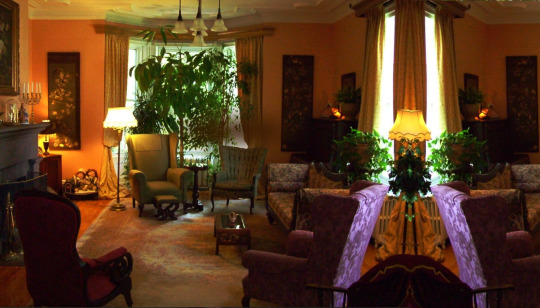
Whether you are to pause for an entire day or two in Sackville, or perhaps, forever, the place takes great pride in the serenity and solitude that it offers to the tourists. Cars slow down when you cross the road. People wave hello and smile. Birds chirp in branches and treetops, the marsh breezes play hide and seek with the sun, and bands play in front of the local residents gathered at the town park.
The quaint town in the southeast of New Brunswick is really blessed with an enviable selection of cultural treats ranging from authentic pieces of work authored by Canadian playwrights to music and arts festivals, such as Live Bait Theater, street poetry, SappyFest, boutique shopping, new media projects, art workshops, dinner theater and also some nifty little cafes to live, laugh, and love. Heritage dining in Sackville, NB (New Brunswick), is something that you are to enjoy for sure. It is absolutely no surprise why it was bestowed the honor of being Canada’s cultural capital in twenty o-eight.
The renowned Canadian painter David Alexander Colville mastered the science of art and taught in this place thereafter. The country’s oldest known university art gallery is that of Mount Allison University and is more popularly called The Owens. Sackville artists work with clay (pottery), canvas, glass, fabric (tees), and paper as well. The Struts Gallery, Fog Forest Gallery, Earth Gallery, Rob Lyons Gallery and also the Craft Gallery proudly boast of their artistic heritage and glorious past.
Sackville’s Boultenhouse Heritage Center speaks of its shipbuilding saga and the famous museum of Campbell Carriage Factory flaunts an eventful history of wheels and woods. The award-winning Waterfowl Park has more than three kilometers of viewing platforms, boardwalks, and trails.
The rustic town is a novel to be enjoyed, a marsh to spend some time in exploration. Along with several quality restaurants as well as a number of heritage accommodations in Sackville, New Brunswick, there are environmental-friendly outdoor outfitters, specialty stores, leather goods shops, and a legendary harness. Every day something magical happens here. It is indeed among the few great stops one is to ever come across in a lifetime.
THINGS AND ACTIVITIES TO DO IN SACKVILLE
Birding
Golfing
Sightseeing
Picnicking
Hiking
Cycling
Skiing
TRAILS, PARKS, AND PLACES OF ATTRACTION IN SACKVILLE
Sackville Waterfowl Park
Tantramur Wetlands Center
Beech Hill Park
Bird Sanctuary at Amherst Point
Blue & Yellow Trails
CULTURAL VENUES IN SACKVILLE
The national historic site of Fort Beausejour
Boultenhouse Heritage Center
Keillor House Museum
The national historic site of Sackville Railway
The textile museum of Saint James
The museum of Campbell Carriage Factory
Owens Art Gallery
Fort Lawrence
Live Bait Theater
Fog Forest Gallery
The Eighteen Fifty-Five House of Captain George Anderson
The Nineteen-Sixteen Covered Bridge
0 notes
Text
My Acadian Roots
Louis William Stievens (Stevens) and Marie Babin
Background
The British and French had many conflicts over the control of the north east coast of North America from the mid 1600’s through the mid 1700’s. The British Conquest of Acadia happened in 1710 (Acadia/Acadie is today known as the Canadian Maritime Provinces of Nova Scotia, New Brunswick and Prince Edward Island). The British gained control of Acadia and on signing “The Treaty of Utrecht” in 1713, allowed the Acadians to keep their lands with the stipulation that the Acadians agree to give their allegiance to Britain. Over the next forty-five years, the Acadians refused to sign an unconditional oath of allegiance to Britain. During this period, some Acadians participated in various militia operations against the British and maintained vital supply lines to the French fortress of Louisbourg and Fort Beausejourt. The British began instituting an “Expulsion” policy, which sought to eliminate future military threats posed by the Acadians and to permanently cut the supply lines provided to Louisbourg.
The Expulsion (1755–1763) occurred during the French and Indian War. During the Expulsion, the British deported Acadians to the Thirteen Colonies and many from there to England. After 1758, Acadians were sent to France. Approximately 11,500 Acadians were deported. Many of the deportees later immigrated to Louisiana, which was under Spanish rule at the time, where they were welcomed with open arms and given small plots of land to develop. The Acadians came to be known as “Cajuns” in Louisiana, a name they carry to this day.
The Family’s Story
Marie Babin, the daughter of Simon Babin (son of Jean Babin and Marguerite Terriot) married Louis William Stievens (seen in records as Steivens, Stebens, Steibens, Estevan, Estiven, Stevens). Louis was born about 1749 in the Catholic Parish of Toussaint, in Boston, Massachusetts, the son of Stanislaus Stievens and Anne Colcein.
Before the birth of Marie, her father Simon Babin and his parents were sent as exiles in 1755 to Boston from Grand Pre, Acadia (Nova Scotia, Canada) as victims of the “Grand De’rangement”, as the Expulsion became known. It was the Bostonians (under British rule at the time), who orchestrated the deportation, removal and imprisonment of the Acadians from what is today Nova Scotia. They also confiscated Acadian properties and monies. Many Acadians arrived on ships with only room to stand and with only the clothing they were wearing and without shoes. Many families were separated, children from their parents and spouses from spouses. The persons sent to Massachusetts were the most mistreated of all the deported Acadians. From Boston, the Babin family members were sent to England where they were interred in a Southampton deportation camp for eight years.
Simon married Anastasie Terriot in 1757 while they were imprisoned in the Southampton deportation camp, and, in September 30, 1760, Marie Babin was born in the camp. Besides Marie, Simon and Anastasie bore another daughter while interred at Southampton.
The British released Marie and her family on May 3, 1763 and sent them on board the ship La Dorothee to a refugee camp in St. Servan, France. Simon and his wife had five more children while living in the refugee camp, but sadly four of the children died there. Simon’s wife also died in the French refugee camp in 1775.
Simon Babin died October 2, 1780 while on board the ship Le Prince Insare. No reason was given why he was on the ship or what he died of.
Marie was in the refugee camp when she and Louis met and married in 1783. Why Louis was in France is not known; he hadn’t been deported. Louis was 38 and Marie was 23. When she married him, they were cousins – not unusual at that time. They lived in the village of Hermitage, situated on a hilltop in Nantes, France.
Acadian refugee family members in France during the years 1775 – 1785, were given three cents a day, on government assistance. Many refugees sought passage to Louisiana with help from Spanish King Charles III, who agreed to pay for their journey. Louisiana was still under the rule of Spain at the time (1762 – 1802) and the immigrants were welcomed to help homestead the area.
On May 10, 1785, thirty-four refugee families, a total of one hundred fifty-six persons, boarded Le Bon Papa and departed Nantes, France, bound for New Orleans, Louisiana. On board, registered as “family number 29”, was Louis William Stievens, his wife Marie, their children; son Louis age 3, daughter Marie aged 2, another son, not yet baptized, age unknown and Marie’s brother, Francois Marie Babin, age 16. Since both Louis and his brother-in-law Francois were listed as sailors on the ship, they most probably used their employment and work on the ship in order to pay for their passage.
The ship Le Bon Papa arrived in New Orleans on July 29, 1785. Captain Pelletier made the voyage in eighty-one days. Understandably, considering the harsh conditions that must have existed on board the ship, the family stayed about a month recuperating in New Orleans.
The expedition, originally consisting of the family members and other refugees on board Le Bon Papa, picked up twelve new members, three through births, nine through new adherents. It lost twelve members; ten through death and three through desertions. Of the thirty-eight families now forming the expedition, thirty-seven voted to settle in Manchac (the area around St. Gabriel, outside Baton Rouge) on the banks of the Mississippi River. One family chose to settle in La Fourche (the area of Plattenville, south of Donaldsonville).
Louis and Marie would have a total of seven children, four girls and three boys. Louis died in 1805 and Marie remarried in 1800 and had one child by her second husband.
Louis was buried in the original St James Cemetery which was moved away from rover due to flooding. No maker exist today to show if he was actually moved or became part of the Mississippi River. Marie is thought to be buried in St Joseph Cemetery in Thibodaux where many of my ancestors are at rest.
What a story considering on his burial records it states that he was an English gentleman. There are many mysteries still at large concerning Louis William Stevens that I have been researching for 30 years now. I am just so glad that genealogy is a great hobby.
0 notes
Photo

DaMajority Fresh Article https://www.damajority.com/flow-connects-saltibus-with-high-speed-internet-hd-tv/
Flow Connects Saltibus with High-Speed Internet, HD TV
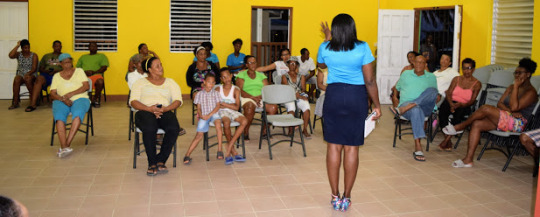
PRESS RELEASE
Flow Connects Saltibus with High-Speed Internet, HD TV
Castries, Saint Lucia (October 5, 2018): Hundreds of residents in the communities of Daban, Getrine, La Haut, Londonderry, Park Estate and Saltibus can now apply for high-speed broadband access and take advantage of high-definition television, as a major technology exercise is underway in those communities.
Starting with Daban, the area is being switched onto the Flow HFC (hybrid fiber-coaxial) network, thus bringing up to 100 MBps high-speed broadband and nearly 200 television channels, including HD programming, to citizens in those localities. In 2017, Flow added dozens of customers on the HFC network in Balca.
With the introduction of service to the Saltibus region, Saint Lucia and the Caribbean’s leading telecommunications service provider is moving towards having its most advanced internet and TV products available to every household on island. The company promised earlier this year to offer high-speed broadband and HD TV islandwide.
Said Country Manager, Chris Williams:
“We are excited about this new development, and from the reception we have enjoyed so far in Daban, we know our customers are excited as well! We promised at the beginning of 2018 to get all of our customers on one network for TV and internet. This will certainly improve service and customer care. In order to do so, we must have the HFC service in every nook and cranny of Saint Lucia, and that is what we are working quickly towards.”
Upon migration, customers are issued a FREE set top box, and will be able to enjoy a FREE View of ALL Flow Digital TV programming for one month from the date of migration. For the first two months, the customer will enjoy Flow TV at a discounted price, based on the legacy LIME products to which they are currently subscribed.
In recent months, Flow has installed the HFC network in locales including Canaries, as well as Grace and Morne Beausejour in Vieux Fort, with upload speeds starting at 10 MBps.
– END –
About C&W Communications
C&W is a full service communications and entertainment provider and delivers market-leading video, broadband, telephony and mobile services to consumers in 18 countries. Through its business division, C&W provides data center hosting, domestic and international managed network services, and customized IT service solutions, utilizing cloud technology to serve business and government customers.
C&W also operates a state-of-the-art submarine fiber network – the most extensive in the region. Learn more at www.cwc.com, or follow C&W on LinkedIn, Facebook or Twitter.
0 notes
Text
Fort Beausejour / Fort Cumberland: A Family Experience
Explore the historic fort where once the future of Acadie and North America hung in the balance. Located on the border between New Brunswick and Nova Scotia, Fort Beauséjour — Fort Cumberland Historic Site stands at the crossroads of Canadian natural https://www.environmentguru.com/pages/elements/element.aspx?utm_source=dlvr.it&utm_medium=tumblr&id=5910872
0 notes
Video
Fort Beausejour, NB by Dave Milton
Via Flickr:
Rebel XS, Mir-20 @f11
20120613 picnic I did not.
0 notes
Photo

Throwback to this summer at Fort Beausejour. Skies are always unreal here. (at Fort Beauséjour)
0 notes
Text
LIFE LESSONS LEARNED: Another Year Of Success For The Effective Speaking Program
(Volume 24-7)
By Anthony Langlois, Air Cadet League of Canada
Back in 1991, the National President of the Air Cadet League of Canada, David Hayden, established a national competition that would affect the lives of air cadets to this day and that would exemplify the potential impact of League members on the Cadet Program. As a signature project to celebrate the 50th anniversary of the League, Hayden developed the Effective Speaking Competition with the help of Executive Committee member J. Robert Goudie and Executive Director Richard Logan.
With the help of sponsors such as WestJet, which provides travel assistance for each cadet speaker as well as a parent/chaperone to attend the national competition, the League’s Effective Speaking Program enables the youth of today to develop an important skill that will benefit them in all their future endeavours.
Cadets start their journey at the squadron level, and then make their way to the regional, the provincial, and finally, the national competition where a grand winner is selected. Located this year in Winnipeg, the honours went to Warrant Officer First Class (WO1) Heather Blake from 514 Kinsmen Squadron in St. John’s, Newfoundland & Labrador. Second place was won by Warrant Officer Second Class (WO2) Cody Lincoln from 249 Beausejour Squadron in Beausejour, Manitoba, and third place by Flight Corporal (FCpl) Samantha Keow from 333 Lord Beaverbrook Squadron in Fredericton, New Brunswick.
WO1 Blake made her prepared speech on the theme of Women in aerospace while her impromptu speech was about Why I like my hometown. This was her second participation at the national level after being a finalist in the 2014 competition. She will age out of the program later this year and here is what she had to say regarding her cadet experience: “I can’t wait to give back to children all the amazing things that were given to me. I am off to Debert for the summer as a Glider Staff Cadet and I can’t wait to be able to share my passion for flight with younger cadets. It is so important for me to share all the things I’ve learned with the next generation coming up through the ranks, and the importance of the Effective Speaking competition is certainly one of them!”
Jay Shah was a finalist at the national competition in Winnipeg where he delivered a speech on Why the Air Cadet Program is important to Canada. He had the following to say about the program: “The National Effective Speaking competition was held the evening of June 15 at the Fort Garry Hotel. This was a wonderful location with a great setup. The Effective Speaking part of the Air Cadet Program is easily one of the least-known aspects of the program, but one with the highest value. One recommendation I would give is to increase the awareness of Effective Speaking so that more cadets become inclined to participate in the future. Speaking is an area that requires practice to do well, but it can help everyone every day throughout their lifetime.”
Next year’s competition will take place in Laval, Quebec, and the new themes for the competition are:
The importance of today’s youth in building Canada’s future.
How does volunteerism play a role in the life of your community or squadron?
Humour is the best medicine.
How space exploration can lead to scientific advances on Earth.
The role Indigenous people have played in Canada’s heritage.
How has Canada changed the face of aviation?
Lest We Forget.
Cadet’s Choice: The Cadet’s Choice must fit into one of these categories: Cadet Life, Science and Technology, Aviation, Canadian History or Citizenship.
In 2018, new cadets will take the stage for the first time while others will build on the skills they learned this year to reach new heights. In the end, they are all winners for seizing this opportunity for their future.
0 notes
